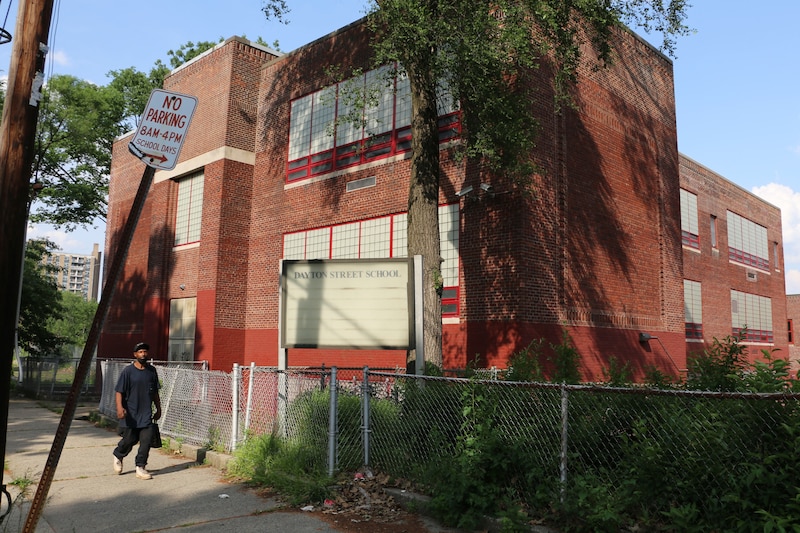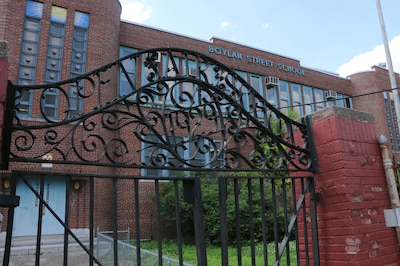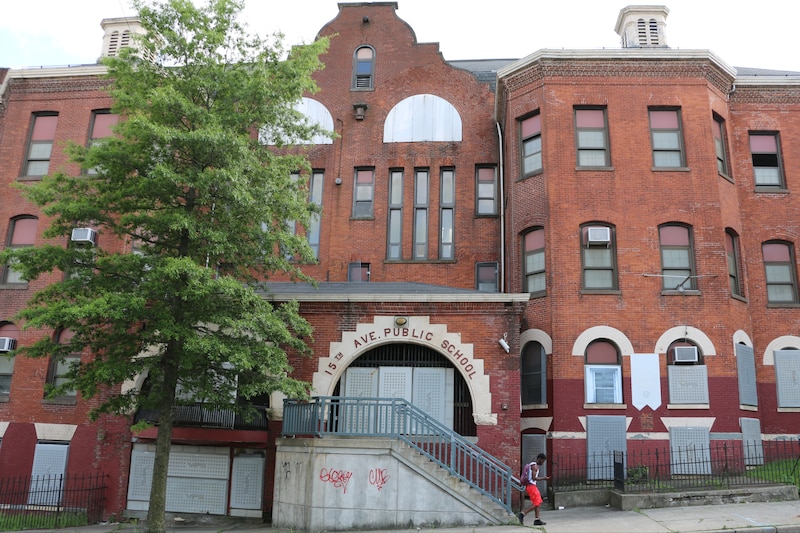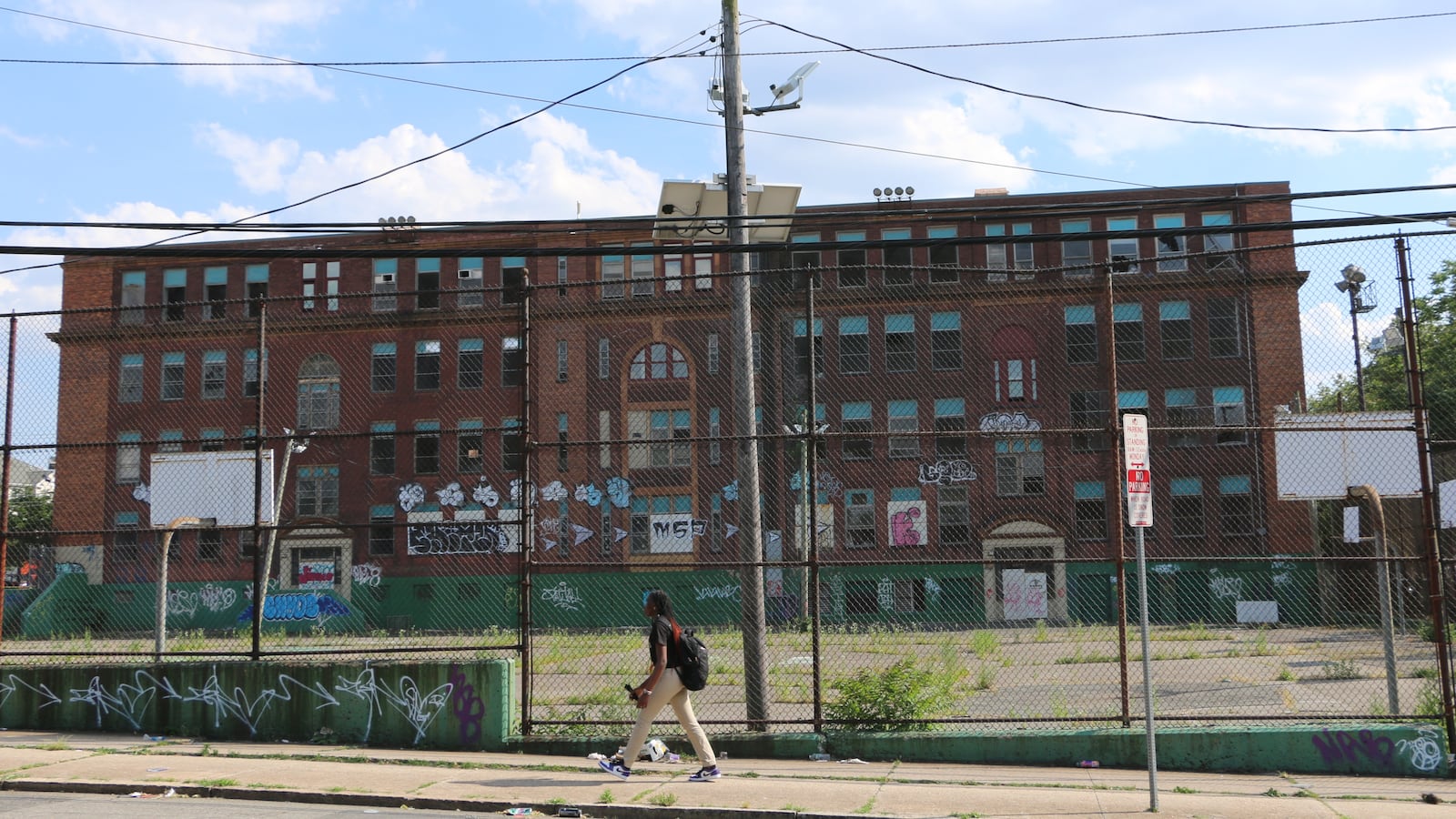Joshcelynne Henderson fondly recalls her childhood school in New Jersey with its green lawns, shiny playground equipment, and bright classrooms.
The elementary school she went to in wealthy Somerset County is a world apart from the one her children attend in Newark. Students there struggle to focus on hot days in classrooms without air conditioning, they couldn’t use the water fountains this year due to lead concerns, and at recess they dart across bare asphalt that serves as both playground and parking lot.
“These schools are old,” she said.
Indeed, the average Newark school building was erected more than 90 years ago, district officials say — more than twice the national average — and many suffer from leaky roofs, outdated boilers, and dilapidated restrooms. Rundown buildings can dampen students’ enthusiasm for school and, in some cases, impair their learning.
Now, Newark wants to modernize its aging schools — a dream which, in the past, has been dashed by inadequate funding.
The district is looking to construct 10 new school buildings and undertake major repairs at more than 60 existing schools, according to an ambitious five-year capital plan, which the state approved in March.
New buildings would be erected for three existing schools, one yet-to-open school, and six closed schools that would be brought back to life, according to the plan, which officials have not discussed publicly. (District spokesperson Nancy Deering said in a statement that officials “will discuss details of those projects with parents and the community as they come to fruition.”)
The plan also calls for some 275 renovation projects, including repairs to roofs and plumbing, electrical, ventilation, and fire alarm systems. Henderson said such improvements would send a strong message to students.
“I absolutely think that if their schools are repaired and updated,” she said, “they’ll see that people care about them.”
But the plan raises an uncomfortable question: Who will pay for it?
Each new building would cost between $15 million and $75 million, and the repairs alone would total $350 million, according to district estimates.
There’s no doubt as to who should write the check. Thanks to a landmark court case, New Jersey must pay for school construction and renovation in Newark and 30 other high-poverty districts — a rarity in the U.S., where districts often must cover their own building costs.
Yet New Jersey has fallen far short of its obligations, spending just $200 million on school construction this year when officials estimate that more than $6 billion is needed. And as Newark asked for dozens of new schools over the past two decades, the state paid for just eight.
As a result, the district patches up antiquated campuses using money that otherwise could buy new books and computers. It is considering issuing up to $1 billion in bonds to fund further repairs. And as enrollment grows, the district has had to lease former Catholic schools, offices, and even a hospital to create more classroom space.
Newark shouldn’t have to do this, said David Sciarra, executive director of the Newark-based Education Law Center. The center launched a legal campaign 40 years ago that led to historic court rulings ordering New Jersey to ensure that children in poor communities have access to well-funded schools in up-to-date buildings.
“The state is on the hook for this 100%,” Sciarra said, and yet thousands of students in Newark and other urban districts continue to learn in schools that are “unsafe, overcrowded, or inadequate.”
“How long are these kids going to wait?” he asked.
Urgently needed repairs
Newark’s school buildings have been falling apart for decades.
In the winter of 1999, icicles formed on a high school’s walls after its heating system broke.
In 2010, a chunk of bricks fell from a school building onto its front walkway just days before first lady Michelle Obama visited.
In 2018, four classroom ceilings collapsed at Lafayette Street School, which was built in 1848 — 13 years before the Civil War.
And a 2019 survey of the district’s buildings found damaged roofs and bathrooms with missing sinks and toilets.
“There were some conditions that I just shook my head and said, ‘I would never send my child to one of these schools,’” said Steve Morlino, the district’s recently retired facilities director, on a podcast last month about New Jersey legal issues. “Therefore, why are they in this condition for other kids?”
In recent years, Morlino oversaw extensive repair work ordered by Superintendent Roger León.
Yet huge troubles remain. At Camden Street School, sewage problems cause frequent flooding on the ground floor, and mice are common in classrooms, said a staff member, who requested anonymity to speak freely about building conditions. And like many other Newark schools, the building lacks air conditioning.
“The third floor felt like an oven today,” the staffer said last week when outside temperatures exceeded 90 degrees.
So once again, Newark has cataloged the repairs that its schools desperately need.
Earlier this year, Newark submitted to the state a new long-range facilities plan, which New Jersey school districts must complete every five years. The plan includes proposed renovations at each of its 65 schools, including new boilers, HVAC systems, windows, roofs, doors, and gyms.
In the meantime, poor ventilation, missing A/C, and outdated heating systems make learning difficult for students, especially the many in Newark who suffer from asthma, said Kim Gaddy, an environmental activist and former Newark school board member.
“If you have a coat on in your classroom, how are you expected to perform to the best of your ability?” Gaddy said. “It makes students think that we don’t value their education — that we don’t value them.”

Room to grow
Since becoming superintendent in 2018, León has been on a quest to grow the district.
He has already opened four new high schools and three elementary schools, with plans to launch several more. But aside from a new building whose construction began before his tenure, León has had to put the new schools on existing campuses or lease vacant properties.
Now the district says it needs more space.
The facilities plan calls for 10 newly constructed buildings. Three would house existing schools — Abington Avenue, Ann Street, and East Ward — that have outgrown their current buildings, and one would feature a new school, also in the crowded East Ward.
The other six buildings would house schools to replace ones that Newark’s former state-appointed superintendent, Cami Anderson, decided to close because of low enrollment and poor performance.

It’s clear the district needs new buildings. But it will have to prove there is demand for so many new schools.
The district’s plan projects that enrollment will grow by about 1,250 students over four school years, reaching 37,621 by 2023-24. But a state report this April said Newark only needs classroom space for an additional 455 students.
Newark officials argue that the growth would be greater if the district had new buildings, which could attract families who might otherwise choose charter or private schools. And as more people move to Newark, the new schools could convince them to stay, Mayor Ras Baraka said last week at the groundbreaking for a new high school the district will open in a leased building.
“People are coming back home,” he said. “They believe in Newark Public Schools, and we’ve got to grow our school system so they stay in Newark Public Schools.”
Schools deferred
Once upon a time, it looked as if Newark’s wish for new, state-funded schools might be granted.
In 1998, and again in 2000, the New Jersey Supreme Court ruled that the state is obligated to pay the full cost of school construction and repairs in high-poverty districts. In response, the state created the Schools Construction Corporation, and the legislature allocated nearly $9 billion for the first round of construction in the 31 neediest districts, including Newark.
In 2001, Newark submitted a plan, which the state approved, calling for 43 new school buildings and 29 renovations at an estimated cost of $1.6 billion. The newly established construction agency began acquiring property for more than 30 of the proposed buildings, and selected architects to draw up blueprints.
But within a year, the construction corporation had blown through all of its funding. A few years later, the state dissolved the agency, citing waste and mismanagement. Newark would have to wait.
In 2007, the state replaced the agency with the Schools Development Authority, or SDA. It eventually built or upgraded more than 850 schools statewide. But like its predecessor, the SDA was accused of mismanagement and ran out of money with many projects left on its docket.
The SDA did make progress in Newark, where it spent more than $760 million on school repairs and eight new buildings. Yet the construction never matched the need.
After requesting 39 new schools in 2005, the district scaled down its request in 2014 to just 15 new buildings. None of them materialized.
One of Newark’s earliest requests was for a new West Side High School. Its building, which opened in 1926, had become overcrowded and plagued by plumbing problems and power outages. In 2009, the SDA made plans for a new $142 million campus. In preparation, the agency bought adjacent property, relocated families from the site, and presented designs to the community.
But after repeated delays, the SDA abandoned those plans with a whimper. In 2017, it sold the property it had acquired for the campus for $1.
“After spending all that money, buying all those homes, displacing all those families, you still don’t have a school at that site,” Morlino said on the podcast.

Will anything change?
With every year of stalled construction, Newark’s needs grow more acute.
In 2016, David Daughety was a freshman at Arts High School. That year, Newark sent the state a list of building conditions that could cause “imminent peril to the health and safety of students and staff.” At Arts High, the conditions included falling pieces of roofing, broken windows, and failed HVAC systems. The district asked for $4.9 million to make repairs at the school.
Meanwhile, Daughety and his classmates sat in classrooms that could be boiling hot or freezing cold, and watched water drip from ceilings into strategically placed trash cans.
“For some reason, that was normalized,” he said.
The state approved just 11 of the more than 150 renovation projects that Newark requested in 2016. Arts High School didn’t make the list.
Six years later, Daughety is finishing his sophomore year of college and Newark has submitted yet another wishlist of school renovations. The cost to repair Arts High has climbed to $7.8 million.
“It sends a message,” Daughety said, “that the state doesn’t really care about inner-city kids.”
This year’s state budget includes $75 million for school repairs, with $6.5 million going to Newark, in addition to the $200 million earmarked for school construction statewide.
Gov. Phil Murphy has proposed allocating another $350 million for school construction in the budget for next fiscal year, and wants to use $150 million in previously borrowed funds for additional capital projects.
But at a legislative hearing in April, Schools Development Authority CEO Manual Da Silva estimated that it would cost roughly $5 billion to replace 50 aging schools the agency has identified across the state, and another $1.5 billion to build schools in overcrowded districts.
The SDA says Newark needs two new schools to address overcrowding — but the agency doesn’t have the money to build them.
Last year, the Education Law Center returned to court seeking to compel the state to pay for those projects and the other schools that poor districts need. A judge is working to determine how much that would cost.
Meanwhile, Newark is trying to fund whatever school improvements it can.
It has spent much of its federal COVID relief money on improved ventilation and other building upgrades, and plans to use nearly $86 million of its most recent round of federal aid on building projects.
Newark also has taken advantage of a state program that allows districts to finance repairs through anticipated energy reductions. Officials say the $120 million in expected energy savings will fund upgrades to 60 buildings, including new boilers, solar panels, roofs, and insulation.
The district also tapped into $30 million that the city raised by issuing bonds to help cover school renovations. But that’s far short of the $1 billion in bond money that León said last year the district might need for repairs.
And while the state has approved Newark’s building plan, that doesn’t guarantee funding. The SDA considers each proposed project individually.
“Unless the governor and the legislature step up and start putting serious money into these projects,” said Sciarra of the Education Law Center, “they’ll essentially remain proposals on paper.”
Now at Rutgers University-Newark, Daughety can only imagine what would happen if every Newark student was able to walk into a state-of-the-art school building.
Improved attendance. Better grades. Brighter moods. Most importantly, Daughety said, the sparkling hallways and modern classrooms would signal to Newark’s young people that they matter.
“When you can give that to students,” he said, “that’s when change starts to happen.”
Patrick Wall is a senior reporter at Chalkbeat. Contact Patrick at pwall@chalkbeat.org.

